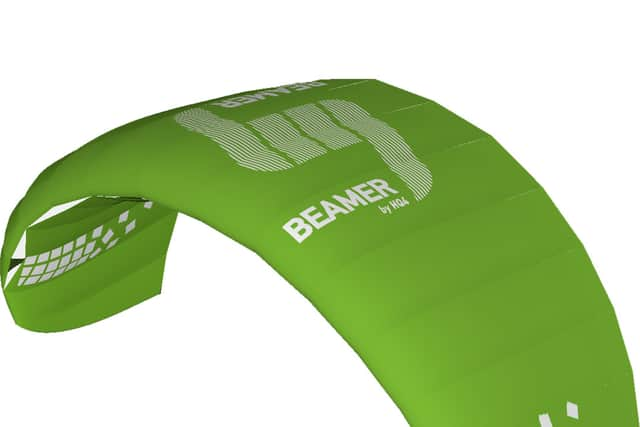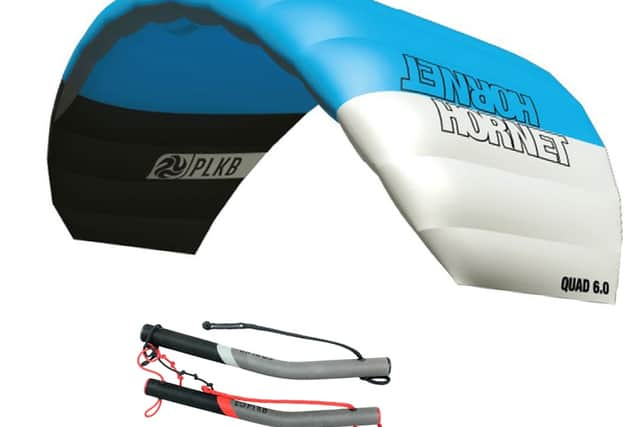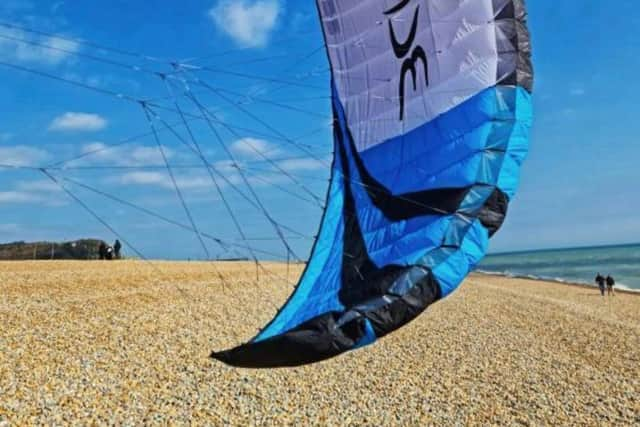Best power kites UK 2022: power kites for beginners, and cheap, 2 and 4 line, Flexifoil recreational kites
This article contains affiliate links. We may earn a small commission on items purchased through this article, but that does not affect our editorial judgement.


For sheer kiting thrills, nothing comes close to the grin-inducing lark of wrestling with a power kite (also known as a traction kite or foil).
Power kiting on land is an exhilarating activity, whether it’s zipping a small two-line kite across the skies of your local park or being dragged along a beach for several metres by a huge five-metre, four-line beast.
Power kiting is also an enjoyably effective way to tone the key muscle groups and generally keep fit. And because they are so amazingly light, they’re perfect for taking on holiday, to the beach or any stretch of open parkland.
What is a power kite?
Modern power kites are made from near-indestructible Ripstop nylon and share the same flying principles as a soft ‘ram-air’ parachute: when under wind tension, a row of chambers (rams) are filled with air and the tips of the kite bow to form a semi-rigid wing which in turn creates impressive lift.
Power kites are flown in a wide arc between the clock positions ten and two – the optimum ‘pull’ occurs within the centre of this window.
Two lines or four?
There are two main types of power kite: two line and four line. Two-line kites are always smaller in dimension and are ideal for children since they don’t pull quite as vigorously and are easier to set up.
However, the four-line system is the one most favoured today, and essential for anyone thinking of taking up land-based motion sports like kite buggying (sitting in a low three-wheeler) or snowkiting (on skis or a snowboard).
Four-line power kites are controlled by two 20 to 25-metre lines attached, via a complex bridle system, to various points on the kite’s underside. A further two brake lines of similar length are affixed to the kite’s trailing edge.
All four lines run down to a pair of vertically-positioned handles held by the flyer.
The top two ‘power’ lines take care of the steering (pull left go left, pull right go right) while the bottom ‘brake’ lines are used for changing the pitch of the kite should a gust become too overpowering.
Four-line power kites also come with ‘kite killers’ – bungee cords that tether the handles to the flyer’s wrists. Hence, if a gust proves beyond control, the flyer simply lets go of both handles, the brake lines are immediately activated, and the kite flops down.
When choosing a power kite, take note that smaller kites require a decent wind to keep them aloft while the largest models can fly in a moderate breeze.
Of course, the stronger the wind, the more traction the kite develops so be very wary of flying a large kite in a strong wind because the pull it generates is immense.
Power kite safety
Powerkiting is an extreme sport activity which can be dangerous when undertaken without due care. Wind can be unpredictable, particularly in built-up areas, so prepare for the odd arm-wrenching gust.
Power lines are dangerous and trees eat kites, so don’t fly near them. And never fly in an electric storm. Finally, wind up the lines carefully when you’ve finished flying or next time you may have a monumental tangle to deal with.
The kites reviewed here are ideal for land-based activities which include both traditional feet-on-the-ground flying and, for the larger models, the extremities of kite buggying and snowkiting.


Flexifoil is widely considered to be the inventor of power kiting so you can’t go wrong with any of its kites.
Indeed, its products are so well made they come with a lifetime money-back guarantee – even if the kite is flown accidentally into a tree and damaged on impact or while retrieving it, simply send the damaged kite back and Flexifoil will replace it with a brand new one. It’s the only kite brand in the world to offer such an impressive guarantee.
With its 2.4m² surface area and 2.6m wingspan, this is the perfect introductory four-line model. To fly, simply attach the ‘kite killers’ to your wrists, hold both handles with the steering line between your index and middle fingers and take a few steps backwards to launch the kite.
The Sting can be steered across the sky in a graceful arc, swirled around in circles or swept in a low 160-degree arc inches off the ground. It provides exceptional pull in a stiff breeze yet it’s really easy to keep under control using the brake lines to reduce the amount of tug or bring it gently to ground.
Rest assured that the traction this colourful sky lark generates will have adults – and sprogs aged 15 and over – grinning for hours. And, as with all Flexifoil kites, it comes in a natty bag to boot.


Available in four sizes (1.6m, 2m, 2.5m and 3m), the three-line V3 is designed as an intermediate power kite for those who want to progress to the extreme sport of kiteboarding on water.
The Ignition V3 Trainer is controlled with the aid of an 18-inch bar tethered to two 18-metre long control lines.
It also has a third safety line attached to the centre of the bar which extends to the wrist via a length of bungee cord (on surf kites it attaches to your waist instead of a wrist).
If the pull becomes too much to handle, simply let go of the bar and the safety line will immediately bring the kite down.
The Imp handles with supreme confidence though some users may find the bar system takes time to get used to.
A great kite choice for wannabe kite surfers and anyone who simply wants to muck about in the park.


While four-line kites aren’t anything like as daunting as you might think, two-line kites are still considered to be the best style of kite for youngsters – and they don’t get much better than the Big Buzz, which comes with both lines attached.
Simply unwind the super-strong Dyneema line, grab a strap in each hand and pull left to make the kite go left and right to make it go right. It’s as simple as that.
Unlike a two-line delta-shaped stunt kite that flits about uncontrollably in a strong wind, the Big Buzz’s larger 1.6m² surface area and 2.05m wingspan keeps speeds to manageable levels, thereby reducing the chances of crashing it into the ground.
And when it does crash, it simply collapses in on itself with zero damage.
This kite is suitable for ages 12 and up though this writer has seen even an eight-year-old fly it with full confidence.
Nevertheless, in strong winds the Big Buzz is capable of generating considerable tug that may even test some adults.


With this four-metre model we’re getting into the realms of serious high-traction power kiting. The Beamer V comes complete with lines and quad handles (with integral kite-killing safety system), a carry bag and a metal ground stake for securing the kite to the ground when not in use.
However, as is the case with most of the kites reviewed here, the lines don’t come attached to the pre-installed bridles, so a few pre-flight setups are required. But thankfully all lines are colour-coded, making attachment straightforward.
The HQ4 Beamer V is well constructed and the soft, rubber-coated handles are comfortable to hold. The tug this kite generates is like having a blue marlin on the end of a fishing line.
It’s a great size for adults and teenagers who want to try kite-assisted jumps but it will drag you along the ground if you’re not careful. If that happens, simply let go of both handles and the kite killers will bring the kite gently down.


Available in six sizes (from 2m to a whopping 6m in width) and with either bar or handle controls, the Hornet is a great choice for beginners to intermediates who fancy the idea of kitebuggying (sitting in a low three-wheel buggy) or land boarding (standing on a big-wheeled skateboard) on a budget.
Made from Ripstop nylon with reinforced leading and trailing edges for extra strength, the 4m model reviewed here provides oodles of predictable pulling power whether you’re fighting it on on legs or being pulled at speed along a beach on a three-wheeled land buggy.
The Hornet comes complete with handles (or control bar if chosen), four sets of 20m Dyneema flying lines, a ground stake and a natty Peter Lynn Hornet bag.
It’s easy to set up and even easier to fly.


This huge, eminently controllable 4.9m² quad-line model requires only a moderate breeze to lift a small flyer clean off the ground and in a 12-15 mph wind the pull is truly colossal.
Just as well it’s equipped with extra strong Dyneema lines plus Flexfoil’s tried-and-trusted kite-killing system.
The Flexifoil Blade was designed with power, pull and lift in mind so it’s especially well suited to buggying, land boarding and recreational jumping. Needless to say, this is not a kite for the beginner, unless you’re built like a brick outhouse.
The Blade is not especially fast but it’s extraordinarily stable in flight and very controllable.
Believe us, flying this beast is akin to competing in a tug-o-war with a buffalo on steroids, even when flown in a relatively gentle breeze. A top choice for heroic flyers.
